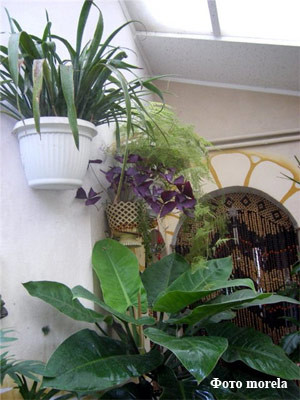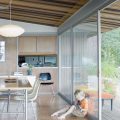 Plant rest is distinguished by organic andforced rest. With organic rest, there is no transition to a magnifying form of growth, due to the particular condition of the plant. To change this state the plant needs a certain time, a certain temperature and lighting. Organic rest is due to the hereditary properties of plants that have evolved in the course of evolution. Forced rest is caused by the lack of favorable conditions for growth. This, in the first place, reducing the illumination in winter and lowering the temperature. If there is enough light and heat, then compulsory peace does not come. Indoor plants can be divided into three groups: 1. Plants, under favorable growth conditions, do not have a period of rest (Tradescantia, cyperus, cleavage, ophiopogon, etc.). These plants can be in winter under normal conditions of containment, only it should be taken into account that some loss of leaves and slowing down of growth are natural when the illumination in winter decreases. 2. Plants that have an obligatory period of rest during the year (orchids, gloxinia, caladium, some cacti, etc.). Plants of this group are painfully tolerated by the absence of a period of rest. For them, it is needed to lay flower buds or spring growth. In the absence of a period of rest, some plants can simply die. 3. Plants for which the state of rest is not necessary, that is, they may have it, but may not have it. These plants can grow throughout the year (amarellisy, krunumi, etc.). For the duration of the rest period, various external factors influence: temperature, soil moisture, light intensity, etc. Low temperature prolongs the rest period, high - shortens it. The forcing of plants is based on this. The dryness of the soil prolongs the period of rest, the humidity reduces. Light also shortens the rest period. Natural conditions are formed so that in winter the light day is shortened so much that it is not enough for intensive growth, therefore most plants slow down growth and are ready for the rest period. It is necessary to reduce the frequency of watering, lower the temperature in the room. Plants, which are characterized by an obligatory period of rest (gloxinia, cyclamen, garnet, etc.) is best placed in a cool, dark cellar, protected from drafts, but at the same time with a sufficient amount of fresh air. In urban apartments, the best place for wintering will be the bathroom, directly under the bathroom. A sign of the end of the rest period is the beginning of the growth of plants. If you removed the pot with the glossini cut off for the winter under a bath, then, looking there in the spring, you will find out that there are shoots from the ground - it's time to get the flower and put it on the usual place on the window. Gradually the usual regime of watering and top dressing is resumed, if necessary, the plant is transplanted. Those plants that do not need a rest period (violets, balm, cyperus, etc.), however, need to water and feed less during the month when the shortest light day. Winter-flowering pot plants that do not need period of rest, you should regularly water and feed the entire flowering time.
Plant rest is distinguished by organic andforced rest. With organic rest, there is no transition to a magnifying form of growth, due to the particular condition of the plant. To change this state the plant needs a certain time, a certain temperature and lighting. Organic rest is due to the hereditary properties of plants that have evolved in the course of evolution. Forced rest is caused by the lack of favorable conditions for growth. This, in the first place, reducing the illumination in winter and lowering the temperature. If there is enough light and heat, then compulsory peace does not come. Indoor plants can be divided into three groups: 1. Plants, under favorable growth conditions, do not have a period of rest (Tradescantia, cyperus, cleavage, ophiopogon, etc.). These plants can be in winter under normal conditions of containment, only it should be taken into account that some loss of leaves and slowing down of growth are natural when the illumination in winter decreases. 2. Plants that have an obligatory period of rest during the year (orchids, gloxinia, caladium, some cacti, etc.). Plants of this group are painfully tolerated by the absence of a period of rest. For them, it is needed to lay flower buds or spring growth. In the absence of a period of rest, some plants can simply die. 3. Plants for which the state of rest is not necessary, that is, they may have it, but may not have it. These plants can grow throughout the year (amarellisy, krunumi, etc.). For the duration of the rest period, various external factors influence: temperature, soil moisture, light intensity, etc. Low temperature prolongs the rest period, high - shortens it. The forcing of plants is based on this. The dryness of the soil prolongs the period of rest, the humidity reduces. Light also shortens the rest period. Natural conditions are formed so that in winter the light day is shortened so much that it is not enough for intensive growth, therefore most plants slow down growth and are ready for the rest period. It is necessary to reduce the frequency of watering, lower the temperature in the room. Plants, which are characterized by an obligatory period of rest (gloxinia, cyclamen, garnet, etc.) is best placed in a cool, dark cellar, protected from drafts, but at the same time with a sufficient amount of fresh air. In urban apartments, the best place for wintering will be the bathroom, directly under the bathroom. A sign of the end of the rest period is the beginning of the growth of plants. If you removed the pot with the glossini cut off for the winter under a bath, then, looking there in the spring, you will find out that there are shoots from the ground - it's time to get the flower and put it on the usual place on the window. Gradually the usual regime of watering and top dressing is resumed, if necessary, the plant is transplanted. Those plants that do not need a rest period (violets, balm, cyperus, etc.), however, need to water and feed less during the month when the shortest light day. Winter-flowering pot plants that do not need period of rest, you should regularly water and feed the entire flowering time.
Important
For some reason, many believe that the dormant period is associatedonly with a decrease in temperature, and if it is warm in the apartment in winter, then the plants do not rest. But in addition to temperature, there are factors such as light, nutrition, etc. In fact, quite a lot of problems, diseases and even the death of plants occur in the winter months, when there should be a forced or mandatory period of dormancy. If you think about it, then most of the plants die precisely over the winter. Mainly from violations of conditions of detention - with a lack of light, not enough cool temperature, proximity to the heating system, too dry air, plants grow poorly and are easily attacked by pests and diseases. If you know that you cannot provide plants with good conditions for growth and development in winter, give them a rest. Try to arrange for them a dormant period so that growth is not significant. Otherwise, if you do not want to arrange a dormant period, balance the conditions so that the plant grows correctly in winter - there are no twisted and small leaves, elongated shoots. To do this, first of all, you need to increase the lighting using one or more fluorescent lamps. It's so simple - you can buy fluorescent lamps in any hardware store (their cost is within 300 rubles). A couple of screws in the wall - and your plant will not only not lose its leaves over the winter, but it can bloom for a long time and please the eye. However, this only applies to those plants that do not need a mandatory dormancy period.









